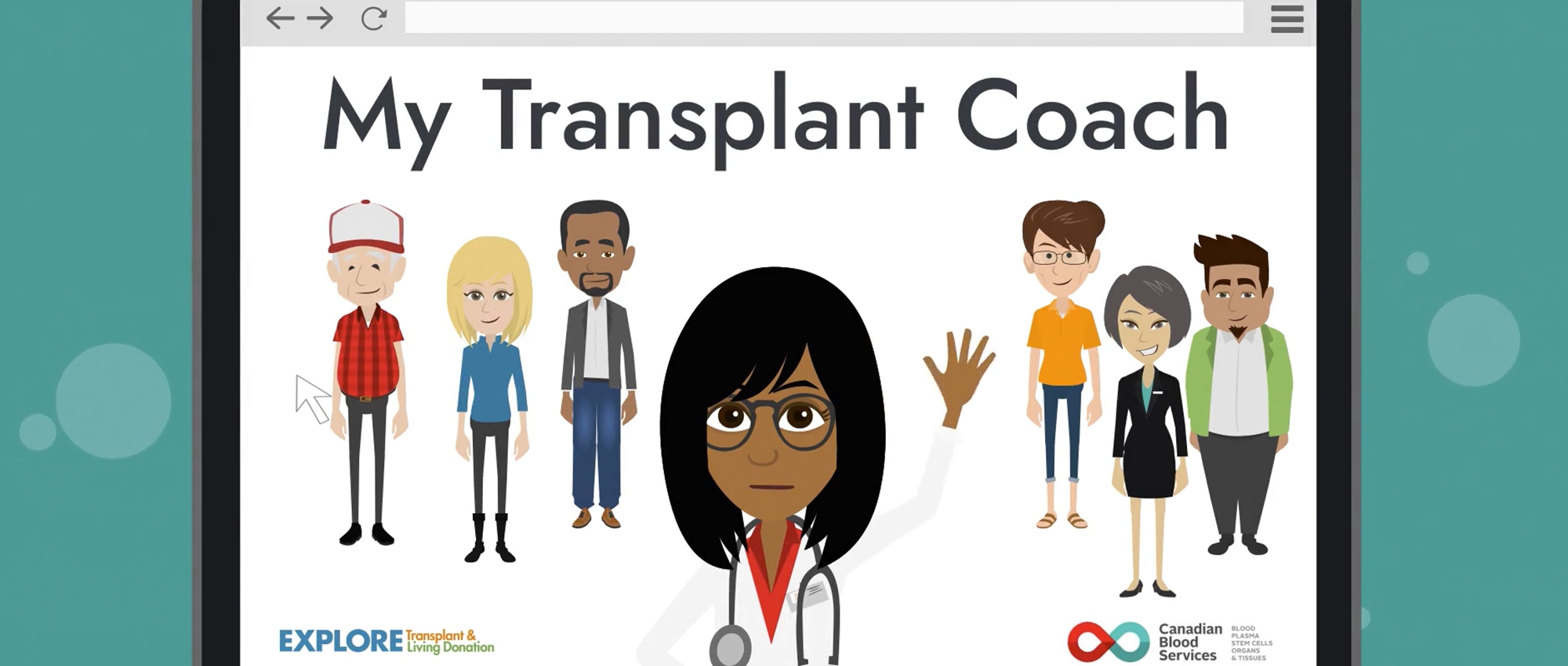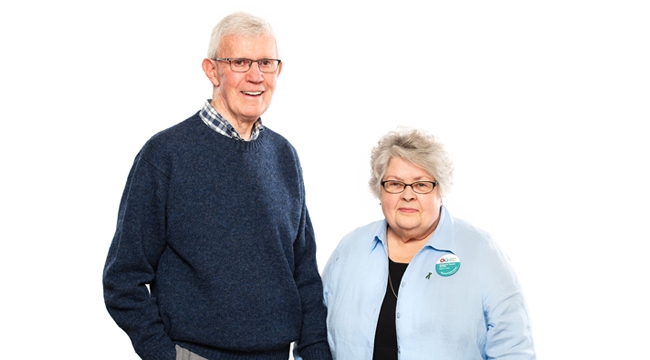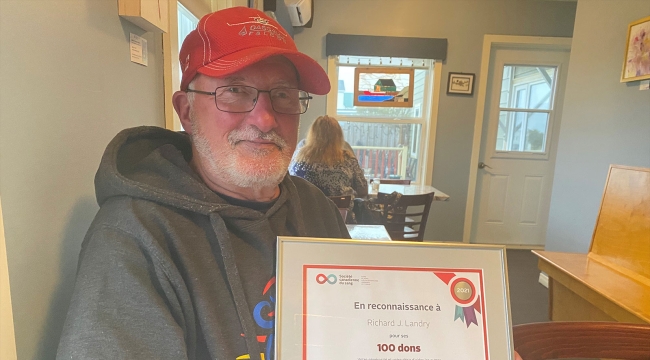Three ways to learn more about the power of living organ donation
These online resources are for potential donors, transplant candidates, and anyone with an interest in organ and tissue donation
Resources for potential living donors and transplant candidates, including My Transplant Coach, are available in our comprehensive resource centre.
Patients in Canada continue to struggle with a shortage of lifesaving organs. At any given time, more than 4,000 Canadians are waiting for an organ transplant; in about three-quarters of cases, they require a kidney. Last year alone, 276 Canadians died while waiting for an organ transplant.
Many people think of organ donation as something that can occur only after they have died. But with kidneys, it is possible to be a living donor, and resume a normal, healthy life with just one remaining kidney.
“Being a living donor is one of the most selfless things a person can do,” says Sarah Parfeniuk, program manager for Canadian Blood Services’ kidney paired donation program. “In addition to saving the life of a recipient, it can also help others. That’s because a person who receives a kidney from a living donor will no longer need to draw from the limited supply of organs from deceased donors. It’s one fewer person on the waitlist.
“Also, in many cases, a kidney from a living donor is the best treatment for someone with kidney failure.”
We believe living kidney donation has the power to eliminate the shortage of kidneys needed for transplants. It’s one of the reasons we have released new educational resources to make living donation an easier topic of conversation for children, families, potential donors and patients needing a kidney transplant. As an organization which routinely works with the Organ and Tissue Donation and Transplantation (OTDT) community to improve national system performance, we have partnered with experts from around the world to provide the following resources to people in Canada.
1. The Living Donation Storytelling Project is a one-of-a-kind digital library of video stories, recorded by real people, sharing their living donation and kidney transplant experiences. It was developed by Dr. Amy Waterman, a nephrology professor at the University of California, Los Angeles, and her team at the Transplant Research and Education Centre. Canadian Blood Services worked with Dr. Waterman and her team to develop a version tailored to Canadians.

Dr. Amy Waterman, nephrology professor at the University of California, Los Angeles, and her team at the Transplant Research and Education Center collaborated with Canadian Blood Services to develop the Canadian version of the Living Donation Storytelling Project and My Transplant Coach Canada.
Sharing one’s unique story of living donation can be empowering for the storyteller as well as inspiring for viewers. It helps increase awareness of the importance of living donation as well as understanding of the donation and transplant process. The storytellers are diverse in terms of age, life experience, where they live and ethnic background.
If you have a personal story to share about living organ donation and transplant, we invite you to join this large community of storytellers looking to make a difference. It’s also a great way for those who are interested in becoming a donor to learn more.
2. My Transplant Coach Canada and My Paired Donation Coach Canada
Being diagnosed with kidney failure can be scary and overwhelming for some patients. They may need help to choose the treatment option that’s best for them.
Dr. Waterman and her team have also developed an award-winning video-based decision aid for patients. My Transplant Coach helps patients understand what transplant treatment options are available, so they can make informed decisions. We worked with Dr. Waterman to develop a Canadian version of this tool called My Transplant Coach Canada, a series of animated videos.
My Paired Donation Coach Canada is a sequel that will also be available on our website soon. This new series of animated videos is designed to help people learn specifically about the national Kidney Paired Donation program and how it may help some patients receive a kidney transplant. It’s aimed at patients, their friends and family, and all potential donors.
3. Brochures in 11 languages
In order to make this important information accessible to as many people as possible, Canadian Blood Services also offers brochures about living kidney donation in 11 different languages. These brochures provide essential information for anyone considering living donation, and they are all available to view or download in our comprehensive resource centre.
“We’re thrilled to offer this wide variety of resources for potential donors and transplant candidates all in one space,” says Sarah.
“These new resources are essential because being informed is a vital step in the journey to becoming a living kidney donor. Medical, legal, ethics and clinical experts, as well as patients from across Canada, have expressed the need for a national website ― a place where anyone can find the latest information and take the first steps toward becoming a living kidney donor.”
This is just the beginning of Canadian Blood Services’ journey to create inclusive and accessible resources for all those in Canada in need of a transplant or looking for ways to give.
This girl received a lifesaving kidney during a pandemic, thanks to a former babysitter
Taking education about organ and tissue donation to new heights

Sarah Parfeniuk, program manager for Canadian Blood Services’ Kidney Paired Donation program, has seen the need for organ donation firsthand.
‘There are just so many people on these lists, and so few kidneys’
For Sarah, the mission to inform the public about living organ donation is deeply personal.
As a registered nurse, she first became interested in living organ donation through her work with Ontario’s Trillium Gift of Life Network and the transplant program at St. Joseph’s Healthcare Hamilton in Hamilton, Ont. But the impact of organ donation also hit close to home in 2014, when Sarah developed a close friendship with a woman she met at the gym. When they met, this woman’s husband had been on dialysis for five years. He was waiting for a kidney transplant.
“I watched him just get sicker,” Sarah recalls. "Deceased donation is a great option, but because there are just so many people on these lists and so few kidneys, it can be a very long wait.”
Fortunately, after seven years on dialysis, he finally received a kidney transplant and is doing very well.
“I see them probably two or three times a year. He swims every day. He is active,” Sarah says. “Sadly, many of his friends have passed away, and he’s become a transplant ambassador to provide support where he can.”
Sarah also knows that even children can find themselves in need of an organ transplant.
“My neighbour's niece had end stage kidney failure as a 10 -year-old and watching her transplant journey was heartbreaking. It opened my eyes to the impact kidney disease has on the entire family, and to the need for living donors across Canada, "says Sarah. “Thankfully, she received a kidney transplant last summer and is back to school, swimming, and being an active 13-year-old.”
“The resources now available on blood.ca help make people aware that living donation can help save lives.”
One organ donor can save up to eight lives, and tissue donation can improve the lives of up to 75 others. More than 4,400 Canadians are waiting for a lifesaving transplant. Register your intent to be an organ and tissue donor through your province or territory and have that all-important conversation with your family.
Patients with kidney disease and people thinking about becoming a living kidney donor can visit our comprehensive resource centre to learn more about living donation and how to get involved.



